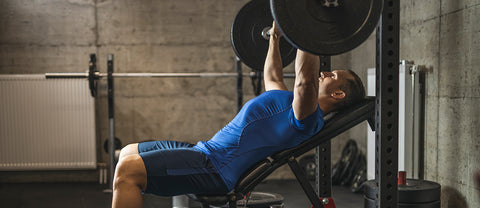When you think of chest workouts, your mind undoubtedly heads to the bench press, and for good reason. The bench press is a terrific exercise and part of any solid workout structure. Everyone – from bodybuilders to Strongmen to CrossFit athletes to powerlifters and even regular weightlifters – is doing some form of upper body press movement. Bench press encompasses many variations, including weight type, angles, breathing, grip, set and rep type, and rest periods.
With all this potential at your fingertips, it can be daunting even to begin a bench press routine. Fear not, for we have the definitive overview of bench press for you to start pressing and develop a massive chest.
Bench Press Muscles Worked
The bench press works muscles, specifically in the chest area. The pectoralis major is the main muscle worked by pressing. Other upper-body push muscles, such as the shoulders' deltoids and the upper arms' triceps, are also used. By using progressive overload – adding total volume over a period of time – you can develop your pecs, delts, and triceps into an impressive physique. And with the bench press considered a compound movement (working multiple muscle groups simultaneously), you can get away with doing only bench press for your upper body push exercise. You don’t need much more than a solid press.
How to Bench Press
Lay on the bench so the barbell is directly above your head. Grip the bar with both hands in an overhand position. Lift the bar off the rack and suspend it over your chest. Lower the bar to your pecs with proper form and slow, controlled movement. The bar should end up an inch or so beneath your nipples. Push the bar straight up in the air without bouncing the weight, returning it to the beginning position. Use your breath as a cadence marker; slowly breathe in during the lowering, followed by an explosive push and exhale while lifting the bar back up. Repeat for the desired number of reps and sets.
As for what the body is doing during the set, you’ll want your backside firmly planted onto the bench, with a slight arch in your lower back lifting the bottom of your spine off the bench. Both feet should be flat on the ground, with everything locked into place. This increase in stability will ensure the correct muscle groups are being worked on – chest, shoulders, and triceps.

Bench Press Variations
Close Grip Bench Press
Where you place your hands on the bar will determine which muscle group works the most. When you opt for a close grip bench press – i.e., moving your hands closer to each other on the bar – you activate more of your upper chest, emphasizing anterior deltoids and triceps. This could assist with shoulder and elbow discomfort but limits the loading potential at higher intensities.Incline Bench Press
You can always go flat with a bench press, but incline bench press and decline bench press can affect different areas of the chest. You can tell the difference based on the movement itself. For an incline bench press, the bar hits above the normal spot a flat bench press would on your chest. Therefore, it works the upper chest.Decline Bench Press
The opposite is true for decline bench presses; these hit the bottom of your chest, so it helps develop the lower chest. The angles don’t have to be drastic because the farther you adjust the angle, the more other muscle groups become engaged, taking away from potential chest gains. Go too far on an incline bench press and you’ll be doing seated shoulder press.
Sets & Reps
Your goals will also determine this. As a general guideline, doing three to five sets of five to 15 repetitions is a good spot. The important thing is to continue adding reps or weight or both every week. This progressive overload is the crux of building quality muscle. The rep range and number of sets can fluctuate, so choosing the reps and sets that allow you to lift with sustainability is the trick. Finding joy in the bench press is pivotal to long-lasting bench press success, so finding a rep range that energizes you and makes you feel good is the name of the game.
Using this information, you can craft a simple bench press strategy leading to a thick, powerful chest.
Article by Terry Ramos

